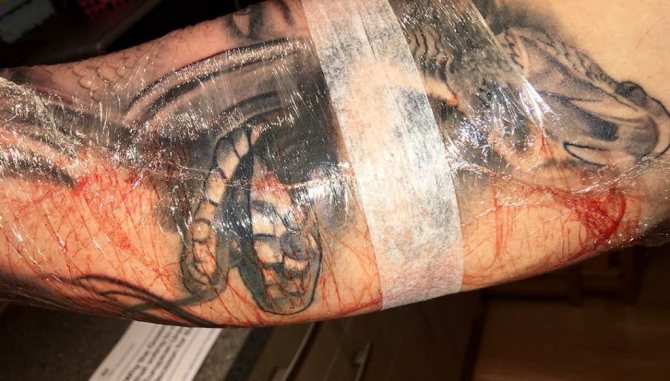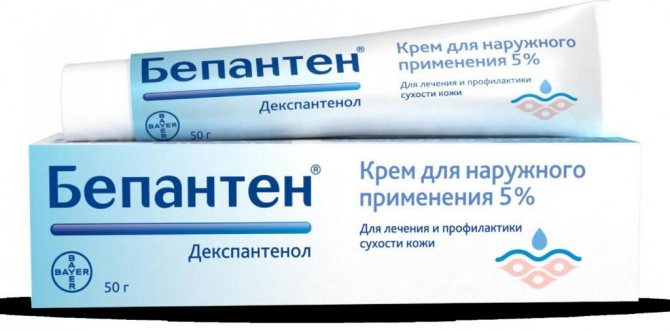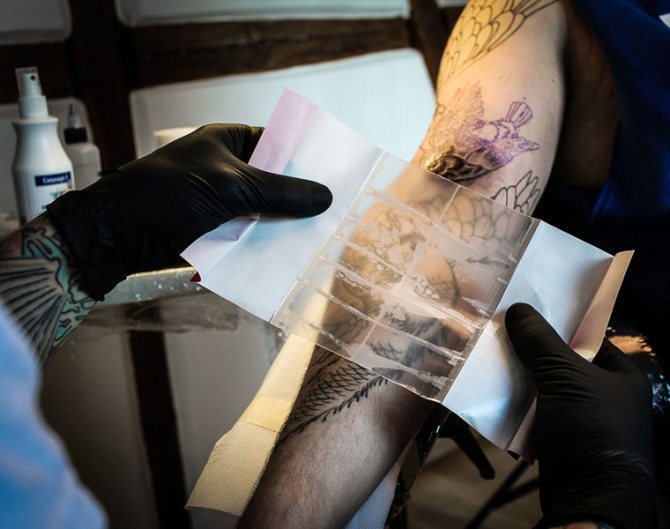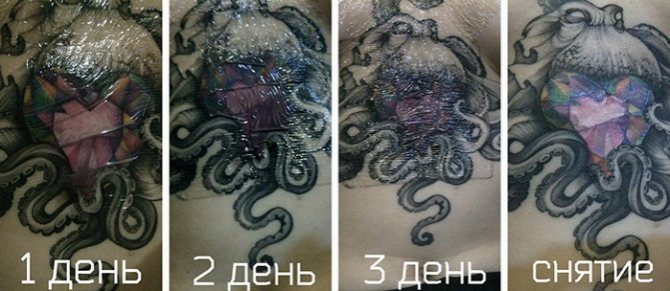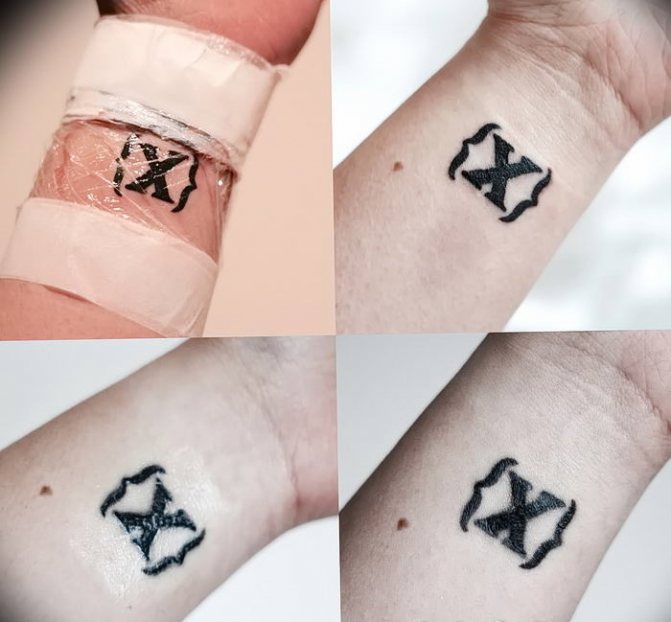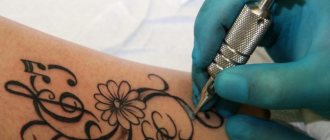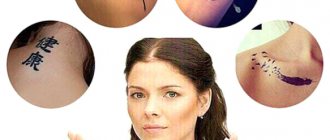So, you got a tattoo. Your new tattoo under the film was shiny and mesmerizing, but a few days have passed and you can't understand what's wrong: the long-awaited tattoo is now covered with sores, emits an incomprehensible liquid, the wound is increasing with each day and is very disturbing...
Perhaps this is not your first tattoo, and with previous works there were no problems at all. You haven't even cared for your other tattoos in any way, and they have healed perfectly. So what's happening now!

The fact that the wound bothers you is already an unpleasant symptom, indicating that the tattoo is infected or an inflammatory process is leading to it. Regardless of the stage of healing of your tattoo, you must take action now, otherwise the consequences could be much worse than you imagine!
Your new tattoo is an open wound and is very susceptible to infection because the layer of epithelial tissue that acts as a buffer and prevents microorganisms from entering the skin has been compromised.
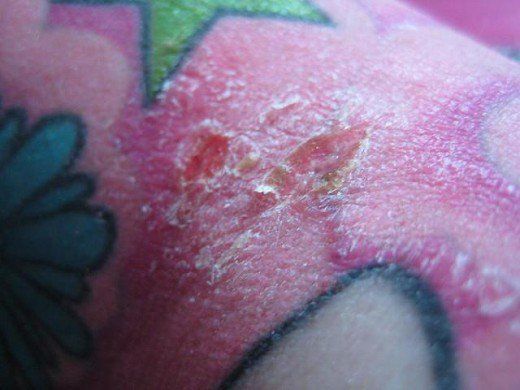

What are the symptoms of an infected tattoo?
Below are the most common symptoms of an infected new tattoo. If you feel or see any of the following, we recommend that you take immediate action.
Swelling This is normal for a fresh tattoo on day one, but if you find that the inflammation increases over three to five days instead of shrinking or even starting to go beyond the outline of the work, this is definitely a problem.
High fever Your tattoo may be hot to the touch. It is normal for a tattoo to have an elevated temperature, especially for the first two days. But the average temperature of the tattooed area should not be very much higher than your body temperature and should in no case rise further. In localized inflammatory processes, the body's immune system warms up the affected tissues so that nonthermophilic bacteria will die on their own. A high fever may be a sign of inflammation.
Discharges Infected tattoos often exude extraneous secretions from different areas. They may appear as a clear, golden-colored liquid, or as a bloody liquid, or as thick yellow-green mucus that is under the skin of the tattooed area. There may also be accumulations of pus (white, yellow or green). See a doctor!
Smell If the discharge from the new tattoo has a foul odor, it is an unmistakable sign that the inflammatory process in the tattoo has gone too far and urgent measures to treat the abscess are needed. You should not let it go to waste.
Pain If you are experiencing severe pain that increases for 3-5 days after the tattooing procedure or sharp cramps are present, shooting up inside the tattoo itself, there is most likely an infection in the wound.
Blistering Blistering is a sign that an infection has developed and this can occur in the superficial part of the tattoo, manifesting as red sores filled with lymphatic fluids.
Increased size of pustules Due to an increase in skin secretions, the scabs on your tattoo may become thickened bulbous and have a yellow or green crust.
Fever and lethargy If you are running a fever, feeling lethargic and these symptoms are not related to other illnesses, it probably means that your body is fighting an infection coming from your tattoo. Fever is actually one of the surest signs of infection, even if your temperature is only slightly elevated.
Signs of infection after a tattoo procedure
- Swelling. Is the norm for the first few days after the drawing. If it does not decrease afterwards, but increases, it indicates the beginning of infection with bacteria.
- An increase in local temperature, i.e. the skin in the tattoo area is warm and moist to the touch. This indicator is considered natural, if it holds no more than 2 days and the area of the figure does not become excessively hot.
- Rash. Characterized by the appearance of small papules or pustules or large blisters on the skin, which may be itchy and itchy.
- Emissions. They are of different nature (liquid, thick, transparent, mucous, yellow, etc.). The most dangerous situation is when pus comes out of the tattoo. This viscous liquid is a mixture of dead epidermal cells, bacterial fragments, leukocytes, eosinophils and other blood fractions, and if it does not come out, it will accumulate under the skin and can soak the surrounding tissues and cause necrosis (irreversible pathological processes), and also spread through the blood or lymphatic vessels to other organs and systems.
Types of tattoos
The method of drawing on the body and the conditions under which this procedure is performed can reduce the risk of cases in which the tattoo may fester.
Amateur tattoos
Applied by amateurs who are inexperienced and frivolous about handling tools. Often the materials for these homemade tattoos are pin, ash or charcoal.
Tattoo traditions (cultural, ritual)
It is customary to make them for each member of a national group (tribe), so that the drawing would attest to its affiliation. The process often takes place en masse in unsanitary conditions, without prior disinfection of instruments.
Professional tattoos
Made in special licensed salons, which have strict hygienic and sanitary requirements.
Cosmetic tattoos
Tattoo (permanent makeup) eyebrows, lips, eyelids. Can be done by amateurs, and can be done at salon masters.
Medical Tattoos
These are symbolic small signs to let people know that the person in front of them is diabetic, blind, etc. Can be made only in sterile conditions by qualified specialists.
Why do people who have been vaccinated need a PCR test?
According to official data, sanitary requirements imply a mandatory test for COVID-19, this is relevant for a number of cases in which there is no division into those who have been vaccinated and those who have not been vaccinated.
Sanitary requirements require all people to take a PCR test for coronavirus when it comes to hospitalization, there are organizations that routinely test staff for COVID-19.
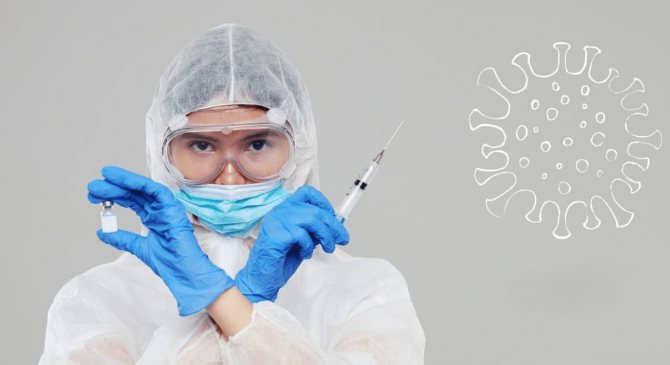

It is possible to fulfill this requirement on a paid and free of charge basis, to specify the price of PCR analysis in our clinic you can by phone or in the Analyzes section.
Practice shows that there is a 10% chance that a person who has received the coronavirus vaccine may not develop antibodies. This is characteristic of all currently known vaccines. Vaccine developers claim that it is common for some people to get sick after receiving the vaccine.
What does the PCR test after the vaccine show?
The PCR test tells you whether there is RNA from the virus in a person's body. After receiving the vaccination, there is no coronavirus or coronavirus RNA in the person's body.
Many people think that the PCR test will be positive after receiving the vaccination, but this point of view is erroneous and does not correspond to the accumulated practical experience on this issue, because there is no infection in the human body, because vaccinations do not contain the active (live) virus.
If necessary, a PCR test can be taken 3 weeks after the vaccination course is completed.
Can there be a positive PCR after the first Sputnik V vaccination?
There can only be a positive result if a person has had time to become infected before receiving the vaccination. After that, it is advisable to get the vaccine immediately, which will help the body build up immunity against the virus. There is a slight possibility that your body temperature will rise after receiving the vaccination, but this is only temporary.
Geraci Medical Center is focused on providing high quality medical services in the clinic, at home and online. We work with sick patients with home visits. All specialists with experience, our own laboratory for tests, and expert-class diagnostic equipment.
We have a 24-hour hotline telephone number +7.
What to look out for when you want to get a tattoo?
- On a cleanliness in the salon, the appearance of the master, the state of his hands.
- On a set of tools (you need to ask how long they are treated and how they are stored).
- At the use of sterile gloves, hand pre-treatment with soap or antiseptics.
- On the availability of a license from the salon.
- The quality of the dyeing substances and the relevance of the needles used - they should be modern, not outdated.
- On the experience of the specialists, on their qualifications.
- On the reputation of the company, on the reviews of people who have visited it.
The differences in the perception of pain in men and women
Women are fragile and delicate creatures, but in the sphere of pain tolerance they are as resistant as the real wars, surpassing men in this sense.
This is largely due to the peculiarities of the structure of the skin. The area of subcutaneous fatty tissue of women extends practically on all surface of back, most part of hips, legs, due to what painful sensations at the tattooing of these areas of body are much less intensive than for men.
The only thing a woman needs to consider when planning a tattoo is her menstrual cycle. During menstruation, as well as a week before it - painful sensations can intensify repeatedly, therefore, experts recommend to refrain from visiting the tattoo salon during this time.
For men, the most painless places are the forearms and lower legs.
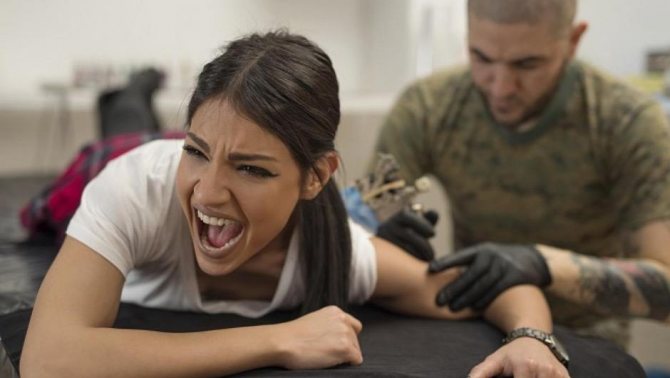

Precautions
You do not need to go to the salon, if you have recently had a viral or bacterial infection, after they recover human immunity at least 2-3 weeks.
You should not drink alcohol on the eve of the procedure, it is necessary to minimize the intake of medications.
Postpone the visit for tattooing, if you have experienced severe stress or nervous tension.
It is inadmissible to go to the salon at the rise of temperature, exacerbation of chronic disease, high blood pressure, headache, with the residual effects of cough or runny nose.
Before drawing ask the master to make only a small area and wait, so you will understand whether you are allergic to the ink used.
Take a hygienic shower before the session.
Strictly follow all recommendations of the masters until the complete healing of the tattoo (try not to get it wet, not to bathe in public water bodies, not to be under direct sunlight, not to overcool).
The most common side effect after tattooing is minor inflammation. But if the skin barrier is damaged, there is a risk of infection. According to studies, 0.5 to 6% of adults who get tattoos have had infectious complications [1].
Tattoos that cause severe symptoms or severe pain that lasts for days or weeks are often infected and require medical attention.
Signs and symptoms of infection
When a tattoo is done by reputable artists in a specialized salon setting, the procedure causes only pain, redness and swelling. With care and good hygiene, most new tattoos heal completely within a few weeks. In some cases, however, tattoos can lead to an infection requiring treatment. This is especially true for people who have a weakened immune system or who are allergic to paints, pigments and dyes.
Symptoms of a tattoo infection include:
- fever;
- Prolonged and severe pain;
- redness and swelling;
- Blisters that contain white or yellow fluid;
- muscle aches;
- constant thirst;
- Hard and red blisters;
- diarrhea ;
- Nausea and vomiting.
Another problem that can occur after a tattoo is Impetigo
- An infection that occurs mostly in young children.
Impetigo
(pyoderma, streptoderma) is a very common and contagious skin infection caused by staphylococci or streptococci.
Causes
Most tattoo infections are caused by exposure to pathogens or allergens.
Known causes of infection include:
Bacterial infection.
Some bacterial infections can be transmitted through contaminated equipment, contaminated ink, and site infiltration of bacteria. Bacterial infections associated with tattoo infections include Staphylococcus aureus and methicillin-resistant Staphylococcus aureus (MRSA). Staph bacteria are a common cause of skin infections associated with tattoos. While many types of staphylococci are treatable with antibiotics, many bacteria have become resistant to most known antibiotics and are very difficult to treat. People with MRSA often experience severe fever, body pain, pneumonia and autoimmune conditions such as rheumatoid arthritis.
Additional complications associated with MRSA infections are:
- Sepsis;
- toxic shock;
- organ failure;
- Infection and edema of heart valve tissues;
- coma;
- death.
Mycobacterioses (non-tuberculous mycobacteria (NTM))
In the past decade, NTM infections have become an increasingly common cause of tattoo skin infections. Most NTM infections are caused by contaminated ink and the use of non-sterilized water when diluting the ink. Symptoms of NTM infections usually include plaques that go away after a few weeks or months.
See your doctor. When do you go to the doctor.
If you begin to feel feverish and experience abnormal oozing or wiping around the tattoo area, see your doctor. These are common signs of infection. You should also see your doctor if the rash or swelling lasts more than a week.
If the infection is not treated quickly enough or cannot be treated properly because the bacteria have become resistant to the antibiotic, abscesses may develop. This may require special treatment in a hospital for removal.
You should also see a doctor if you experience uncomfortable itching around the tattoo area, or if pus or fluid rises in the area. You may have an allergic reaction to the ink.
An allergic reaction can also lead to anaphylactic shock. This causes your throat to close and your blood pressure to become dangerously low. Go to the emergency room immediately if such an allergic reaction occurs.
Treatment
Professionally done tattoos cause only minor inflammation. Rest and ice usually help alleviate most of the side effects. Anti-inflammatory medications such as paracetamol can provide relief in the first 8 to 24 hours after tattooing.
Antihistamines such as Diphenhydramine can reduce the symptoms of mild allergic reactions such as small red blisters or a mild rash around the tattoo.
Creams, ointments, or antibiotics are prescribed to treat most skin infections. If serious illness such as viral infections or blood infections are suspected, a small skin sample may be taken from the affected area for laboratory examination and diagnosis. The method of treatment is determined by the specific cause in each individual case.
Prevention
The easiest way to prevent or reduce the risk of infection when getting a tattoo is to choose a licensed artist and reputable salon. People with compromised immune systems, blood or skin infections should refrain from getting tattoos to avoid further complications and the risk of infecting others.
Which will help reduce the risk of infections:
- Choose salons that have been in business for several years and have a large number of reviews.
- Evaluate the cleanliness of the salon before proceeding with the procedure. A dirty room is often a sign of an overall unsanitary environment.
- Make sure the artist is using new needles and sterile equipment.
- Make sure sterile swabs and antiseptics are used to clean the skin area before starting the procedure.
- The practitioner should wear sterile gloves throughout the procedure.
- Never get a tattoo in a questionable place.
- People with allergies should talk to the artist in advance about the ink they use.
Additional methods to prevent infection after tattooing:
- Wash your hands with soap and water at all times;
- Apply antibiotic ointments to the tattooed area once or twice a day;
- Cover tattooed areas with sterile gauze or bandages;
- Use moisturizers to reduce the risk of scarring.
How to properly care for your tattoo if it becomes inflamed?
Is your new tattoo not healing as it should? If you're seeing swelling, festering, mucus, blisters and other symptoms of tattoo inflammation, it's best to go to your doctor for medical attention or at the very least, call your artisan for a consultation.
Tattoo Inflammation. Care
Along with seeing a doctor, you should do the following:
- Before you do anything to the tattoo, wash your hands thoroughly with soap and water and dry them with a clean towel or dry air.
- Rinse all excess fluid and pus from the tattoo with warm water. Avoid getting the wound too wet and use antibacterial detergents. Wash the tattoo exclusively with your hands, but not with a cloth: the cloth leaves lint in the wound, which can aggravate healing.
- Rinse the tattoo in a weak solution of salt water (saline solution). Dissolve about 1-2 tablespoons of salt per liter of warm, boiled water and gently rinse the inflamed area of skin.
- Do not disturb or tear the sores! Carefully wash away any foreign particles and excreted fluids. Damaging and scraping the crusts will definitely damage your tattoo.
- Dry the wound very gently using a clean, lint-free cloth or allow it to air dry.
- Make sure the wound is completely dry.
- Use any healing ointment prescribed by your doctor or pharmacist, following the directions for use. This can be Levomecol ointment or Bepanten cream.
- Wrap your tattoo in sterile gauze for when you go outdoors or in public places. Also, wrap your skin when the tattoo is wet, when you sleep, and when you wear clothing that may rub and irritate the fresh tattoo.
- Try to keep your tattoo as dry as possible, except when applying prescribed ointments. Ideally, the tattoo should neither get excessively wet nor dry out. Keep the site of the wound comfortable.
- Protect your new tattoo from sunlight as much as possible.
Remember, the healing process of the tattoo determines how it will look in the future. Wounds and crusts can lead to scarring, and improper use of ointments can cause the paint to spread beyond the design. Be neat, careful and healthy!
Complications related to tattoos
- scarring;
- Infections that occur one year after healing
- Long-term inflammation associated with the tattoo;
- Sensitivity to light;
- neurosensitivity and pain;
- pigmentation spreading to other areas of the skin;
- Enlargement of a lymph node;
- Keratoacanthomas.
Most tattoos stop causing unpleasant symptoms within a few weeks. Although most infected tattoos are treated with ointments or oral pills, skin and blood infections can cause life-threatening complications.
OutlookOutlook
Tattoo infections are usually easy to treat and even easier to prevent. Most infections can be treated within a week with antibiotics and rest. However, some infections can be very serious and require long-term antibiotics or other medications.
Learning how to choose a good tattoo artist and take care of your tattoo is crucial to ensuring that your tattoo is treated well, that you do not get infections, and that your tattoo looks the way you want it to.
Bad infections can lead to long-term antibiotic care, but they usually do not cause long-term health problems. Rarely, though, you can get a condition like hepatitis or HIV with a tattoo needle or untreated infection. In these cases, you may need more intensive and long-term treatment.
